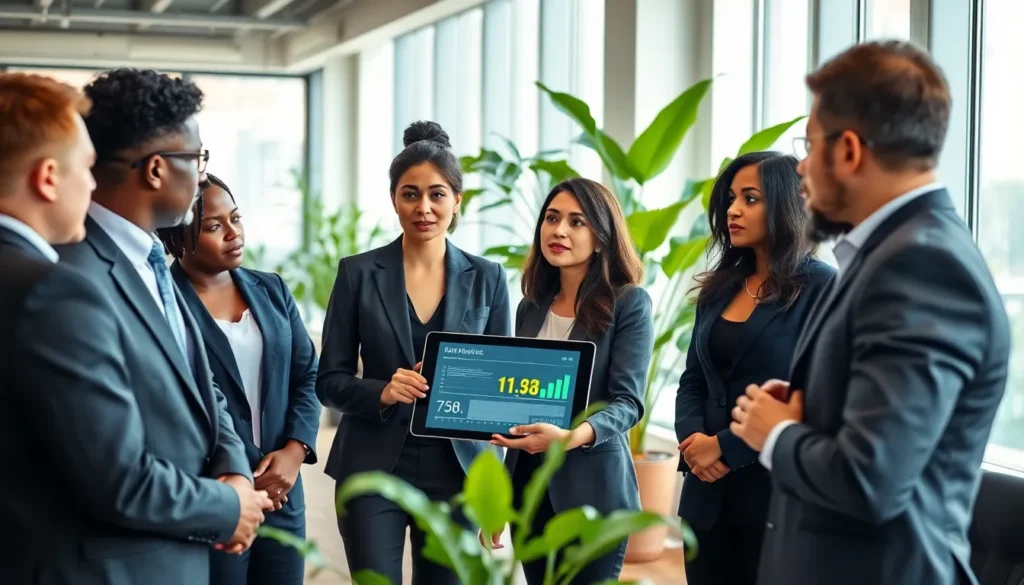In a world where technology evolves faster than a squirrel on caffeine, sustainable IT is no longer just a buzzword: it’s a necessity. Technology leaders have a unique opportunity to drive change, making their organizations both innovative and environmentally responsible. Imagine a future where technology not only boosts productivity but also puts a smile on Mother Nature’s face. Intrigued? Read on to discover how technology can thrive sustainably.
Table of Contents
ToggleUnderstanding Sustainable IT

Sustainable IT refers to the practice of utilizing technology in a way that is environmentally friendly, economically viable, and socially responsible. It’s about aligning IT strategies with sustainable development goals, not only to minimize environmental footprints but also to enhance social equity. This concept embraces the entire lifecycle of IT products, from design and usage to disposal. It means choosing energy-efficient hardware, promoting virtual meetings instead of travel, and opting for cloud solutions that use renewable energy sources. The goal is to integrate sustainability into the core of IT operations, leading to a positive impact on the planet without compromising on performance.
The Importance Of Sustainability In Technology
The importance of sustainability in technology cannot be overstated. With climate change looming like a dark cloud, the tech industry faces mounting pressure to do its part. By adopting sustainable practices, organizations not only adhere to regulatory mandates but also boost their brand reputation. Consumers today are more aware and demanding, often preferring products and services that prioritize sustainability. Research indicates that companies committed to sustainability tend to outperform their competitors. Plus, a sustainable approach can lead to cost savings, especially through energy-efficient technologies and reduced waste.
Also, sustainability in technology promotes innovation. When teams are challenged to find greener solutions, it often results in novel ideas and products. So, investing in sustainable IT is not just about being kind to the planet: it’s about future-proofing businesses and ensuring long-term viability.
Key Strategies For Implementing Sustainable IT
When it comes to implementing sustainable IT, a structured approach is key. Here are some tried-and-true strategies that technology leaders can adopt to foster a more sustainable IT environment.
Frameworks And Best Practices For Sustainable IT
Organizations should begin by selecting appropriate frameworks to guide their sustainability initiatives. The ITIL (Information Technology Infrastructure Library) framework has a specific focus on sustainability and can help align IT services with business objectives. Plus, frameworks like the UN Sustainable Development Goals provide a broader context for measuring success.
Best practices include:
- Green Data Centers: Transitioning to energy-efficient data centers can lead to substantial reductions in power consumption.
- Virtualization: By consolidating servers and using cloud computing, companies can reduce physical hardware needs, leading to less electronic waste and energy usage.
- Telecommuting Tools: Investing in virtual communication technologies minimizes the need for business travel, lowering carbon footprints.
Measurement And Reporting On Sustainability Efforts
Tracking sustainability efforts is essential in determining success. Technology leaders should establish clear metrics to measure the impact of their sustainability initiatives. Key Performance Indicators (KPIs) related to energy consumption, waste production, and resource utilization can provide valuable insights.
Tech leaders might consider creating annual sustainability reports to showcase achievements and ongoing projects. Transparency attracts stakeholders and promotes accountability.
Challenges In Achieving Sustainability Goals
Even though the benefits, technology leaders face several challenges in achieving sustainability goals. One major hurdle is the initial investment required. While sustainability practices can lead to cost savings in the long run, the upfront costs of purchasing energy-efficient equipment or transitioning to cloud services can be daunting.
Another challenge lies in resistance to change. Employees may have entrenched habits that are hard to break. Engaging staff through training and workshops can help overcome this resistance, fostering a culture of sustainability.
Also, measuring sustainability efforts can be complex. With many variables at play, establishing accurate metrics is often a significant challenge. Organizations must invest in robust data collection methods and analytical tools to enable precise measurements. So, understanding these challenges allows technology leaders to create targeted strategies, ensuring more effective outcomes.
Future Trends In Sustainable IT
The landscape of sustainable IT is continually evolving. Some trends to watch out for include:
- Circular Economy Models: Rather than following the traditional linear model of ‘take, make, dispose,’ organizations will increasingly focus on reusing resources.
- Artificial Intelligence: AI is poised to play a critical role in predicting energy usage and optimizing IT operations for maximal sustainability.
- Remote Work Solutions: As hybrid work becomes more mainstream, sustainable tech solutions that help this transition will gain popularity, reducing the need for physical office space.
Besides, as regulations tighten globally and consumers demand greater accountability, companies will need to adapt quickly. Embracing these trends can place organizations at the forefront of sustainable innovation.

